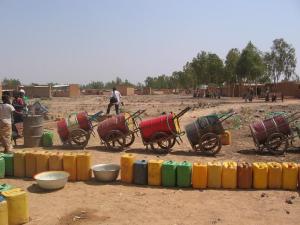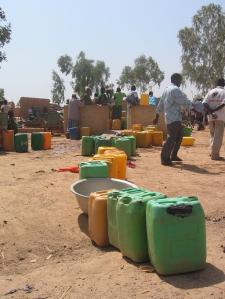The defecation calculation and talking shit
Posted: February 13, 2011 Filed under: Sanitation 4 CommentsI spent the end of last week at a workshop organised by WaterAid and its partner organisations in Mali (a mix of local NGOs and local government technical units) to discuss the progress in piloting Community-Led Total Sanitation (CLTS) in their regions. CLTS is an approach to promoting hygienic sanitation practices which emerged in Bangladesh in 1999 and has since spread rapidly. CLTS relies on a mix of shaming, inspiring and supporting communities to abandon open defecation and construct their own latrines, rather than the previous common – and often unsuccessful – approach of subsidising toilets.
The facilitation process is supposed to use the crude local equivalent word for ‘shit’ in a variety of participatory exercises which provoke collective realisation in communities of their consequences of their shitting habits, and a commitment to group action to address them. One example is the calcul de cacas (‘the defecation calculation’ would be the elegant English translation). This involves the community calculating the mass of faeces they produce individually and collectively per day, week or year, and then thinking about where this goes. If open defecation is practised, this could be water sources, children’s hands, flies’ legs – and ultimately people’s mouths and stomachs.
Some of the key findings from WaterAid’s pilot studies in 12 villages in Mali so far:
• In villages which lacked sufficient latrines and where people practised open defecation, the process stimulated enough construction for almost all households to have a toilet. In most cases, these were ‘traditional’ Malian pit latrines with the slab covering the pit made of wood and dried mud. This is similar to previous CLTS initiatives in other countries where the first step is getting on the ‘sanitation ladder’ with traditional latrines, and hoping that people later upgrade to more hygienic options (for example, with concrete slabs which are easier to clean).
• In some villages, where open defecation was less of a problem, the CLTS approach helped make this second step: the total number of latrines in the villages did not change much, but owners upgraded from wood and mud to concrete latrine slabs made by trained masons in the villages.
• Although the participatory methods of CLTS may work with people, animal shit is still a problem. In some evaluations, people joked that “We have to keep the animals in our courtyard so they are close to the house, otherwise [insert name of rival ethnic group according to Mali’s system of kinship joking] would steal them!”
One of my key interests is the link between the CLTS approach to stimulating better sanitation practices, and other hygiene promotion initiatives that have encouraged people to upgrade and protect their own wells to improve the quality of water available – I should be beginning some field visits on this soon.
The challenge of targeting investments
Posted: February 9, 2011 Filed under: General Leave a commentI’m just back from a conference in Ouagadougou, Burkina Faso, organised by WaterAid in West Africa to discuss and promote its approach of working closely with decentralised local governments in the region to support water and sanitation provision. The most interesting part of the event for me was a visit to a peri-urban municipality of Ouagadougou. In a meeting at the mayor’s office, we discussed how the council had developed a local development plan for water and sanitation with support from WaterAid’s partners and discussion with community representatives. The local government then began the process of seeking funding for the plan’s implementation from central government, donors and the local private sector.
However, despite the intention that this planning process would help prioritise the areas most in need of improved water and sanitation services, the second part of our visit showed the difficulty of achieving this. We saw a community on the outskirts of the municipality, far enough from the city centre to be the beginnings of rural Burkina Faso, where over 1000 people were using a new handpump designed to serve 300 users – resulting in the queues shown below. Meanwhile in the part of the municipality closer to the city, funds had been allocated to a new public tapstand connected to the main water network, in an area which already had some other tapstands and household connections. There was not time to discuss the details of this case, but various possible reasons emerged for the apparent discrepancy. Connecting new tapstands to the existing piped urban network is usually cheaper than drilling extra boreholes in areas further away, so when funds are limited (and need to be spent rather than saved) the cheaper option becomes the priority rather than the area with greater pressure on existing services. Also, ‘rural’ areas like this which technically fall within urban municipalities may miss out on the funding allocated by donors to the rural water sector, but are not yet considered viable for connection to urban networks.
This example is a good reminder that targeting the poor and marginalised is always a challenge in development. WaterAid’s policy team is working on a much wider study about targeting in the water and sanitation sector which should be completed later this year.
A Mali Half-Marathon
Posted: February 9, 2011 Filed under: General 1 CommentWhat better way of spending a Sunday morning than running 20km round the Mali countryside? I found out about the Bamako marathon two days too late – and might have struggled to compete with the 1500 Malian soldiers who entered – so the shorter version organised by the Bamako Hash House Harriers was a better option. A start time of 7.30am meant we could set off in the cool morning breeze. Losing the trail, missing the drinks point, and doing a lot of backtracking meant some of us did more than 20km and finished in the midday sun. Luckily the drinks were still ice-cold, my bag of bananas was only slightly warm, and I still had time to get to the airport for my plane to Ouagadougou.



